Four Main Reasons Why Septic Systems Fail
There are four main reasons why septic systems fail. Some are inexpensive repairs that can be made by the homeowner in an hour or so, but others require more intensive diagnosing and are far more costly to repair. They are highlighted below.
1. Leaking Plumbing in the house
The first and most frequent reasons septic systems fail is because of leaking plumbing in the home! Go through your home and see if you can find any leaking faucets or toilets. Leaking Toilets are the most frequent cause of septic overloading. If you have a leaking toilet, Immediately have it repaired, because by leaving it running, you overload your system.
The Culprit is in the tank. Check the flapper or the float and fill valve to see if it is leaking.
A quick fix is to change the valve inside the toilet tank. Check for dripping faucets and anything that may run water into the drain. Building permits are usually not required for this work.
2. Running Storm Drains into the Septic
This set-up will cause problems
The second most common reason for septic system failure is due to septic overloading by running floor drains, sump pumps, eaves troughs and water-softener back-flush into the septic system.
Since all these sources are just clean water, you end up dumping excessive water into the system that does not need to be there.
This is the proper rainwater discharge set-up
To repair this, divert this excess water to the surface or pipe it to a ditch. For the eaves-trough, discharge the rain leader to the grass, and not down to the septic system.
Building permits are usually not required for this work.
3. Broken or Clogged Plumbing and Piping
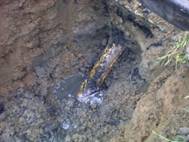 The third most common reason for septic system failure is due to broken or clogged plumbing or piping. Frequently piping settles due to time and soil movement. Back when your septic system was originally installed, either PVC or clay tile was used to connect the septic tank to the septic bed. If the soil settles enough, the pipe will flex and bend or break, backing up the system.
The third most common reason for septic system failure is due to broken or clogged plumbing or piping. Frequently piping settles due to time and soil movement. Back when your septic system was originally installed, either PVC or clay tile was used to connect the septic tank to the septic bed. If the soil settles enough, the pipe will flex and bend or break, backing up the system.
Another location that breaks frequently is where old cast-iron pipe is used to exit the home and then is converted to clay tile or PVC once outside. The old cast iron pipe rusts and breaks, causing clogs.
Most frequently, we see where the inside of the home has been converted from cast iron to ABS pipe, but the plumber who did the conversion was too lazy to break out the pipe from the block wall, so he or she stops short of replacing all the cast iron, and leaving 6” inside the basement .
Then later another contractor arrives to install a new septic system, and the contractor replaces the cast iron pipe from 6” outside of the house to the new septic tank. This leaves two feet of rotting cast iron pipe left just inside, through and just outside of the wall. Then it rots away and clogs, and brings tremendous smell inside the house.
A new ABS will look like this
To fix this, you must call a repair expert such as Slagter Construction to replace the broken pipe with ABS out of the home and new ABS or PVC to the septic tank. Usually a repair permit will be required.
If the Piping is clogged long enough, it will allow roots, dirt, stone and even animals to make its way into the piping system. When this happens, your septic bed is probably in need of replacement.
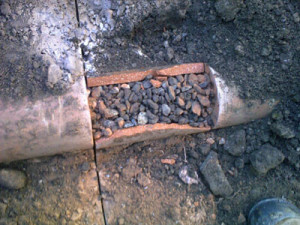 Here is a photo of a clay tile header pipe fully clogged with gravel. It must have washed in over time and completely clogged the system.
Here is a photo of a clay tile header pipe fully clogged with gravel. It must have washed in over time and completely clogged the system.
The only way to find this out is to open up the septic system and find out what is going wrong. Since this is like exploratory surgery, it will cost the homeowner money to find out what is wrong and then he or she may have to have the entire system replaced. A repair permit or a replacement permit will be required.
4. Biomat Buildup
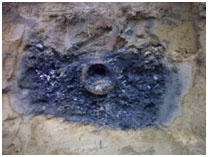 The fourth most common reason for septic system failure is due to biomat buildup inside the septic system. Biomat is a sludge-type of buildup of black material that clogs everything it comes in contact with.
The fourth most common reason for septic system failure is due to biomat buildup inside the septic system. Biomat is a sludge-type of buildup of black material that clogs everything it comes in contact with.
Biomat build up is nearly unstoppable, so this means that EVERY septic system begins to die, as soon as the first toilet is flushed.
Septic systems last longer when there is less waste flushed down the system, but eventually every system that is used daily will fail.
The only time we see systems live on for a long time is when they are in optimal soil conditions (sand) and they are given long rest periods between usage, specifically in cottage situations. A home with 2 people and a large tile bed will last a lot longer than a home with 6 people with a small tile bed.
When clogging reaches 50% your tile bed will begin to blow out, causing effluent to begin leaking on to the surface. You will see black-colored water leak out on to the soil and you will have a horrible smell! To repair this you will need a new system and a building permit will be required.
Clean Weeping Tile and Stone looks like this
If you are in need of assistance to determine why your septic system is failing, please contact us at:
Support@SepticSystemsOntario.com
Or simply fill out the form in the right column and we’ll contact you within 1 to 2 business days or sooner for emergencies.

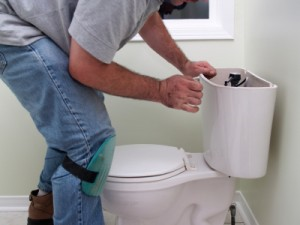
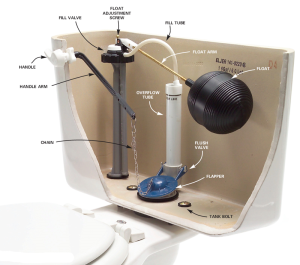
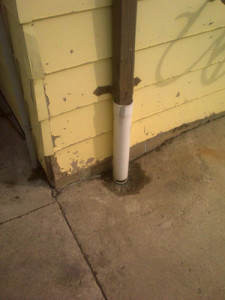
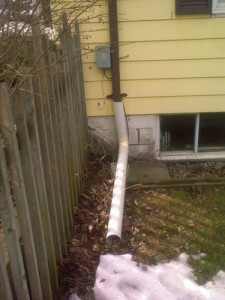
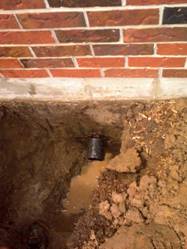
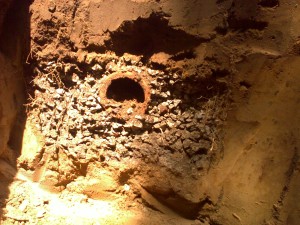

Write a Comment